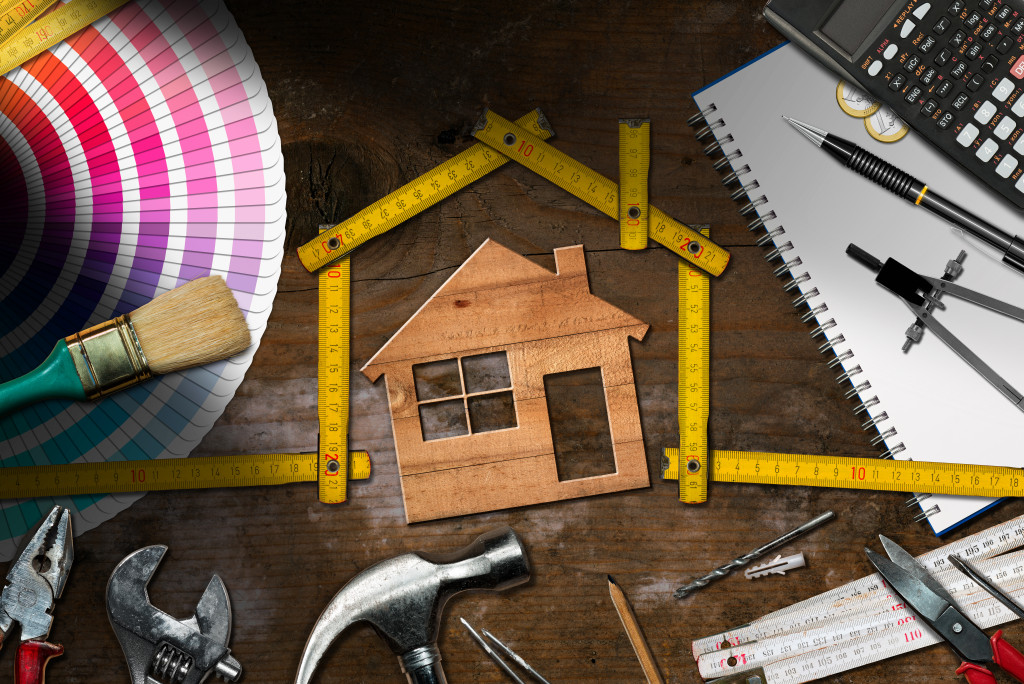Doing home improvement projects on a budget can be tricky. So, when your renovation money is limited, it’s important to pick projects carefully. Choose the materials, timeline, and workforce that won’t force you to spend more than you should.
Here’s a list of home improvement projects you can do without hurting your budget and will give you your money’s worth in the long run.
Upgrade Your Bathroom
- In keeping with the environment-friendly trend, you may want to install a low-flow toilet. This kind of toilet uses significantly less water than a regular toilet but still flushes efficiently. You can save money on water bills with this fixture.
- Refresh your shower doors as well. A frameless glass shower door that’s affordable yet looks elegant will be a nice upgrade for your shower stall. The absence of metal frames makes the place appear bigger. Soap scum rarely builds up on glass doors, so it will be easier to clean.
- Install a bathroom exhaust fan to prevent moisture accumulation in one of the most humid areas of your home. Moisture buildup can lead to the growth of mold and mildew, which can be expensive and tiresome to remove.
- Re-caulk the cracks. This is a quick and easy DIY fix that will have your bathroom looking spic and span.
Dress Your Walls
An easy, practical home improvement project that you can DIY is to give your walls a new look. Repainting is a favorite project among homeowners. If you’re worried about choosing the right color, TapPainter is a free mobile app that can help you out. It uses augmented reality (AR), so all you must do is take a picture of the wall you want to paint, and the app lets you choose from a wide range of existing paint colors to get a virtual sample. It even has a network of professional painters you can contact if you’re not feeling up to DIY-ing.
You can opt to use wallpaper to dress your walls. If you’re indecisive or live in a rented space, you can find many different temporary wallpaper designs.
Revamp Your Flooring
Sometimes, you need to choose durability and longevity over low prices, and flooring is one of those home parts where you need it.
One of the most common types of flooring materials is carpet. It’s inexpensive and solves the problem of noisy footsteps. It’s also soft, so it’s good to have at home if you have kids running around and falling all the time. The main downside of carpeted flooring is that it’s hard to clean and not the most durable type.
If you want new floors that would last, consider laminate, hardwood, cork, and vinyl plank floors. Of these four, vinyl plank and cork are more affordable and easier to install. If you’re worried about your kids’ safety, you may add rubber play mats on the areas they frequent and retain your vinyl floors for a more aesthetic look.
Replace Your Clothes Washer

To save on electricity and water bills in your laundry, replace your old washer with an efficient one, and improve the way you do laundry. A high-efficiency washer per se is a good solution, but it depends on how often or how long you use it. High-efficiency laundry appliances are more expensive than regular units, and their biggest marketing claim is that they’ll save you more money in the long term. They’re meant to be used with high-efficiency detergents that require less water than traditional detergents to clean your clothes.
That sounds good. But for most high-efficiency washers, it would take about six and a half years to reap the rewards of your investment. As opposed to marketing claims, you don’t save that much energy in these washers. High-efficiency washers use heated water to wash clothes and high-pressure sprays to rinse them. According to ColdWaterSaves.org, water heating uses up to 90% of a washing machine’s energy consumption. So even though you use less energy to heat less water, the heating function itself consumes energy.
Hot or warm water temperature may not be the best option for the longevity of your clothes or non-colorfast fabrics. You get to save on your washer, but not on your clothes.
To get the most out of your washer purchase, what you can do is skip using the dryer unless necessary. You can wash your clothes as recommended in your efficient new washer but dry them the old-fashioned way: air drying. Use your dryer only when you need to use a piece of clothing the next day. Otherwise, hang them out to dry.
Get Plants for Your Home
Having plants at home is always a good idea. They’re beneficial to your mental and physical health. They clean the surrounding air and lower anxiety and depression. Research about green walls – a vertical garden – shows that having a green wall at home can also help you save on air conditioning bills in the summer. Green walls keep the surrounding air temperature cool by as much as 46 degrees F.
To save money on your grocery budget, you may also plant a vegetable garden at home. It’s better for the environment because you help lessen the carbon footprint from food transportation. Vegetable gardening is also an excellent way to educate your kids about plant food and encourage them to eat more fruits and vegetables.
When doing home improvement projects on a budget, choosing the right projects is the key. Some materials are expensive upon purchase but may save you time and money in the long run. Other upgrades help prevent or minimize wear and tear of your home. Depending on your lifestyle and what sacrifices you’re willing to make (or not make), choose your home improvements wisely.

